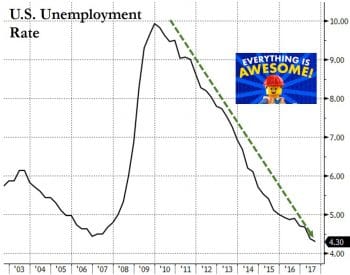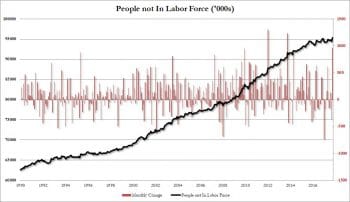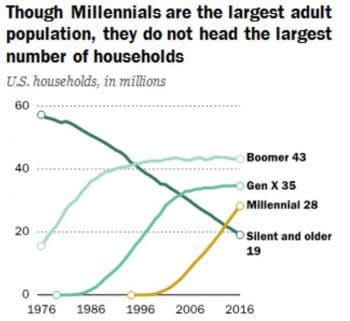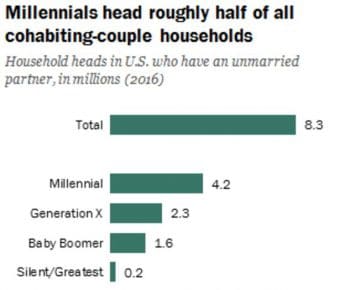Nary a day goes by that President Trump and/or the talking heads on CNBC fail to mention the following unemployment chart as evidence that “everything is awesome” with the U.S. economy…
…which might be true unless you’re among the 95 million-ish Americans who have been looking for a job for so long that you no longer even count as a human being to the Bureau of Labor Statistics…
…or if you’re a millennial.
Despite being the most educated generation ever to walk the face of the
planet, at least according to their tuition bills paid by mom and dad, a
staggering number of millennials still can’t seem to land a steady job. Moreover, despite the steadily improving labor market, as the USA Today points out, the outlook for millennials continues to inexplicably deteriorate with 20% of 26-34 year olds currently living at home with mom versus only 17% back in 2012.
The share of older Millennials living with relatives is still rising, underscoring the lingering obstacles faced by Americans who entered the workforce during and after the Great Recession.
About 20% of adults age 26 to 34 are living with parents or other family members, a figure that has climbed steadily the past decade and is up from 17% in 2012, according to an analysis of Census Bureau data by Trulia, a real estate research firm. The increase defies record job openings and a 4.1% unemployment rate, the lowest in 17 years.
Not surprisingly, a much larger portion of younger Millennials age 18 to 25 (59.8%) live with relatives, but that figure generally has fallen the past few years after peaking at 61.1% in 2012.
So why does the professional development of millennials continue to diverge from other generations? While one can never be sure, perhaps the answer to that question lies in the personal experience of young Heidi Toth who decided to quit her job, after gaining just two years of experience, to join a church mission for nearly two years. Then, after returning to work from her travels, Toth quit again in 2013 after a “series of layoffs modified her duties”…which we assume roughly translates to...”a bunch of people got fired which meant I had to work harder so I quit.”
After graduating from Texas Tech University with a journalism major in 2005, Heidi Toth, now 35, got a job quickly at a Provo, Utah, newspaper. But in early 2007, she went on an 18-month church mission, landing her back in the job market in the depths of the recession in 2008. Unable to find work, she moved in with her mother in Roswell, New Mexico, for nine months while she hunted for work and took part-time, low-paying jobs.
She was rehired at the Provo paper in spring 2009 but left again in 2013 after a series of layoffs modified her duties. After months of fruitless job searching and traveling, she returned to her mother’s house for three months until she was hired at a Lubbock, Texas, paper.
Toth was grateful she could live rent-free during her periods of unemployment. But, she adds, “It wasn’t ideal, professionally or personally.”
Prospective employers in larger, distant cities didn’t think she would be readily available for interviews. And at home, “I felt like I was back in high school,” she says. “I felt like I had to ask permission to go out.”
Meanwhile, as the Pew Research Center recently noted, even the Millenials that manage to hold a job and establish their own residence aren’t much better off as they now head more households living below the poverty line than any other generation and, in aggregate, represent nearly one-third of all impoverished households in the United States.
More Millennial households are in poverty than households headed by any other generation. In 2016, an estimated 5.3 million of the nearly 17 million U.S. households living in poverty were headed by a Millennial, compared with 4.2 million headed by a Gen Xer and 5.0 million headed by a Baby Boomer. The relatively high number of Millennial households in poverty partly reflects the fact that the poverty rate among households headed by a young adult has been rising over the past half century while dramatically declining among households headed by those 65 and older.
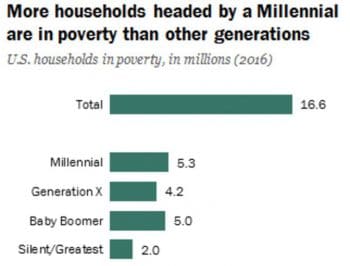 Of course, that’s all despite the fact that they only head just over 20% of all households…
Of course, that’s all despite the fact that they only head just over 20% of all households…
Millennials are the largest living generation by population size (79.8 million in 2016), but they trail Baby Boomers and Generation Xers when it comes to the number of households they head. Many Millennials still live under their parents’ roof or are in a college dorm or some other shared living situation. As of 2016, Millennials (ages 18 to 35 in 2016) headed only 28 million households, many fewer than were headed by Generation X (ages 36 to 51 in 2016) or Baby Boomers (ages 52 to 70).
Of course, those aren’t the only stats that prove just how much those anthropology degrees are paying off…Millennials are also winning at the ‘cohabiting-couple’ game…presumably because it takes a village of millennials to cover one monthly rent bill.
Conclusion:


